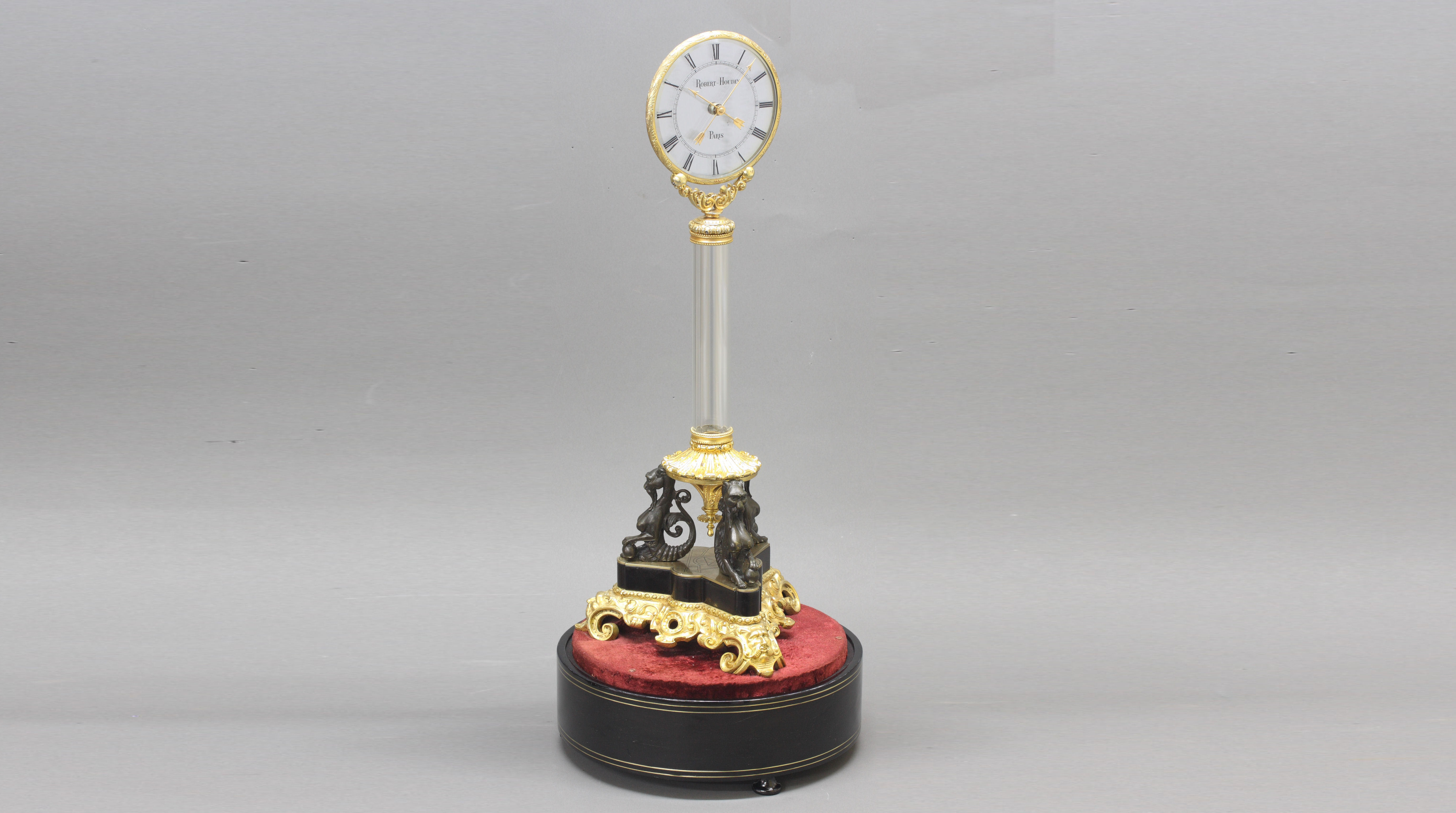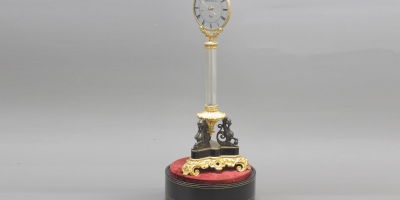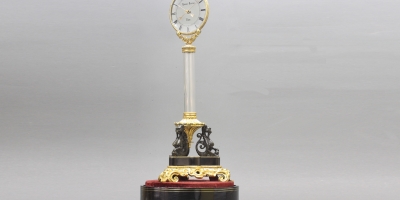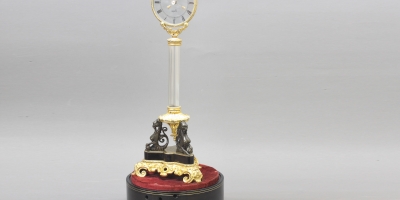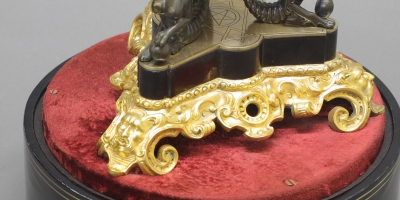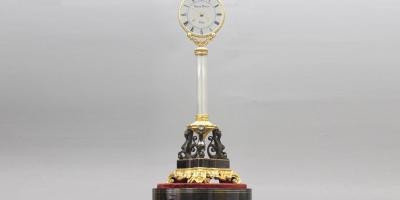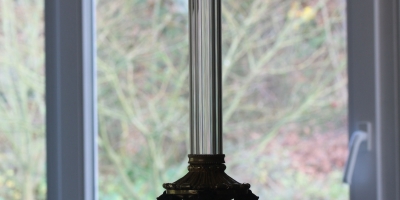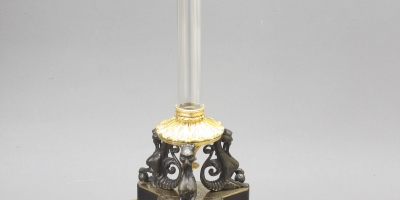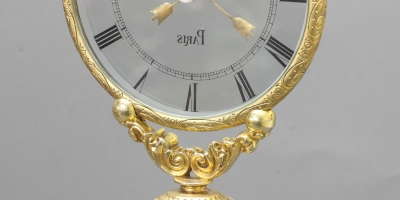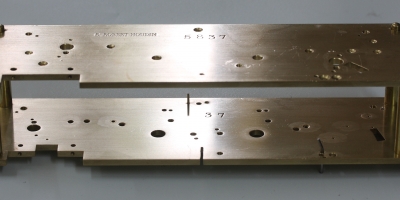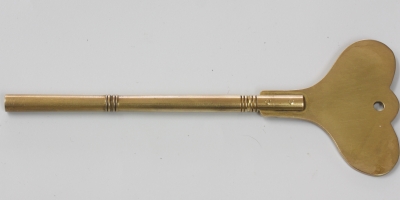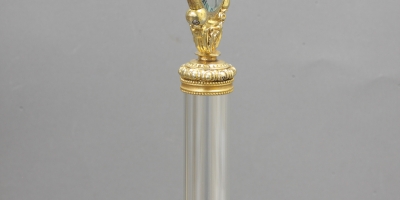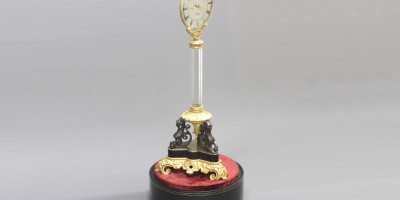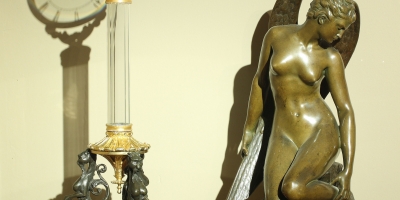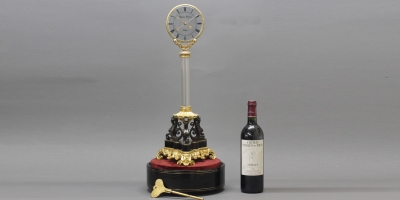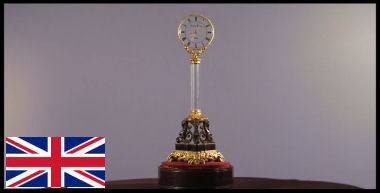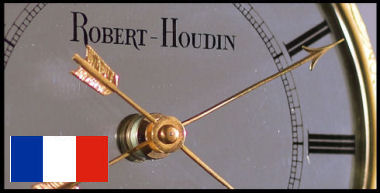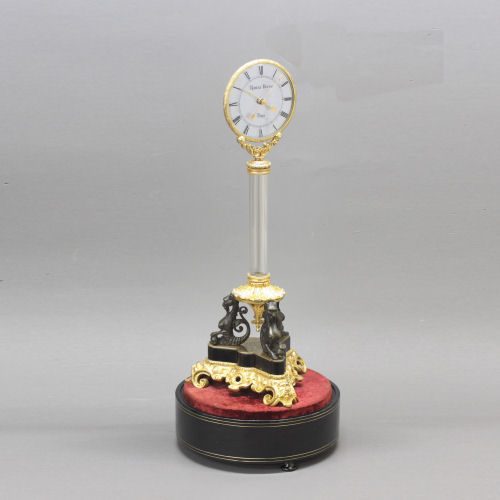Jean Eugène ROBERT-HOUDIN, “Triple Mystery” Clock, Paris, circa 1850. Crystal, patinated and gilded bronze. Signed on the dial: Robert-Houdin/Paris.
The circular dial, made from three clear glass plates of near-identical size, indicates the hours in Roman numerals and the minutes with precision indicators, with two arrow-shaped gilt-brass hands. The hours and signature are painted on the back of the first glass plate; the second glass plate contains the motion work in its center and moves with the hour hand, the third glass plate is the rear support of the assembly.
The whole dial is contained by a gilt-brass surround that sits in a chased gilt-bronze mount supported by a crystal column terminating in three patinated-bronze griffins on a shallow ebony-simulated terrace decorated to end in gilt-bronze scrolls and grotesque motifs.
Like the dial with multiple glass plates, the crystal column is actually made of two separate crystal tubes, the inner one being fitted with rotating wheels at both ends. A long rod with an endless screw is the link between the glass inner column and the removing middle dial, it is hidden within one of the decorative dial supports.
Another such long rod with lantern pinions on both sides is hidden within one of the three griffins, and acts as the link between the movement and the crystal column.
The movement, unable to be contained inside the base, is concealed within the circular black-lacquered pedestal bordered with fine brass fillets, the top covered in crimson velvet.
It is made of two separate trains (one for the strike and the other for the time) with all wheels placed in a linear fashion so as two place them all in a narrow space. The movement ends with a platform escapement in a line, with Swiss-type escape wheel, and cut bi-metallic balance wheel. The strike is every hour and half hour on a coiled gong attached in the base and controlled by a countwheel. The movement is stamped E. Robert-Houdin and numbered 3857 on the winding side. The same very long brass key is used for winding and setting the hands through 3 holes at the rear of the base.
Dimensions
Height 57 cm (22 ½ "), Diameter of dial: 12 cm (4 ½ "), Diameter of base: 26 cm (10 ¼ ").
Jean Eugène ROBERT-HOUDIN
(Blois, 1805 – Saint-Gervais, 1871) Horologist, illusionist, stage artist.
‘I am inclined to believe’, noting in his biography “Confidences”, that I came into the world with a file, a compass or a hammer in my hand, for from my earliest youth, these instruments were my rattles, my toys; I seemed to use them as other children learned to walk and talk.’
All his life, Jean Eugène Robert-Houdin was ruled by his passion, or mania, to invent and perfect, never ceasing to surprise and fascinate; his scientific and technical innovations as well as his remarkable talent as a magician secured his place in history.
The son of horologist Prosper Robert, Jean Eugène Robert-Houdin was born in Blois on 7 December 1805. Established as an horologist in Paris around 1835, Jean Eugène began his training in his father’s workshop. Although Prosper Robert insisted that his son pursue a legal career, Jean Eugène preferred the domain of horology and began an apprenticeship under his cousin Jean Martin Robert, reputed to be the most skilful horologist in town.
Blois, home to the kings of France since the Renaissance, was one of the major horological centres at the time – in 1700, there were no fewer than 200 clockmakers working there. It was also here, in his hometown, that Jean Eugène Robert met his future wife, Josépha Eglantine Houdin, daughter of the well-established Blois horologist, Jacques Houdin, a monumental clockmaker who was summoned to Paris in 1820 to work for Bréguet. In late 1829, Jean Eugène Robert began working for his future father-in-law as a clock dealer, and on 8 July 1830 married his daughter whose surname became inseparable from his own, hyphenating it from then on as Robert-Houdin; it was officially recognised by Prince-President Louis-Philippe in 1852.
Shortly after his marriage, Robert-Houdin established himself in Paris where he became known for the construction of ingenious automata and machines of his own invention. He first settled at 63, rue du Temple, repairing clocks and watches. Nevertheless he continued to invent, creating a cabinet of curiosities where he would produce a series of completely new mechanical devices that were marvels of ingenuity. He was awarded numerous prizes and medals throughout his lifetime, including first-class bronze, silver and gold medals at the 1839, 1844, 1855 and 1859 French Industry and Universal Exhibitions.
Among his first inventions was the alarm-lighter clock for which he filed a five-year patent on 20 September 1837 for ‘an alarm clock whose function was to have light upon waking.’ It was activated by a watch movement with verge escapement, which released a small candle at the chosen hour — the tip of which, filled with a substance similar to that of German matches, was lit through friction. The success was such that it proved to be a financial boon to Robert-Houdin for many years to come.
This commercial success allowed him to move to 13 rue Vendôme, hire employees and devote himself to the construction of automata, among which were ‘The Player with the Beaker’, ‘The Dancer on a Cord’, ‘The Singing Birds’ and the creation of his first masterpiece of horology: the mystery clock. The latter, as we have seen, was the horological expression of his talent as illusionist and became an object of curiosity, highly sought after by amateurs and collectors alike.
After this fruitful period, Robert Houdin devoted even more time to creating automata. At the Universal Exhibition of 1844, he exhibited on a circular platform his timepieces and other mechanical devices such as the ‘Writer-Drawer’, which King Louis-Philippe himself admired, and was finally sold for $4000 to the famous American showman, P. T. Barnum. Once again, the Central Jury confirmed his success, awarding him a silver medal for all his inventions.
He continued to invent, the list of which includes innovative devices like the electric distributer, electric regulator clock, a mechanism to detect leaks on ships, an electric plastron for fencers, a speedometer for automobiles…. without forgetting his famous “magic clock” invented in 1845, a true masterpiece, which he demonstrated as a stage act.
Like the mystery clock, the magic clock’s hands moved without any apparent connection with the driving mechanism; two separate cords suspended the glass dial and bell, which, with a wave of Robert-Houdin’s magic wand, would obey the various orders and commands stunned spectators might suggest .
In addition to his talent as inventor, Robert-Houdin had a charismatic personality that enabled him to perform on stage and captivate his audience easily. Theatre lover, illusionist and actor at heart, he opened his own conjuring theatre at 14 Galerie de Valois at the Palais Royal in Paris. On 3 July 1845, Robert-Houdin premiered the first of his four “Soirées Fantastiques” where he paraded a host of mechanical marvels that would respond to his voice, obeying the commands that spectators would suggest. For numerous years he triumphed before his public, earning a reputation worldwide. His fame was such that in 1848 he travelled to London to perform at the St. James’s Theatre, and also before Queen Victoria, who extended a personal invitation to have the magician perform at Buckingham Palace!
In 1855, Robert-Houdin and the Maison Destouche exhibited together at the Universal Exhibition, where they were awarded a First Class Medal for seven inventions: an electric regulator clock, a mantel clock, several large bell-tower dials, a mechanism to turn electric current on during the day and off at night, a new electric SMEE battery, an electric distributer (precursor of the electro-magnetic motor) and a new device to transfer electric current.
To this endless list, we can add that Robert-Houdin was one of the pioneers of the electric clock, for which he filed a patent in 1855.
Bibliography
Tardy, Dictionnaire des Horlogers Français, Paris 1971; Polichinelle, Jan-Oct 1983, pp. 40-48; Francis Maitzner, Jean Eugène Robert-Houdin, Horloger, mécanicien, prestidigitateur “L’histoire de sa vie,” Bulletin ANCAHA, no. 58, été 1990, pp. 5-17; Richard Chavigny, Jean Robert-Houdin Horloger, Bulletin ANCAHA, no. 58, été 1990, pp. 19-28; J.C. Gendrot La pendule mystérieuse de Robert-Houdin Bulletin ANCAHA N° 58, été 1990, pp. 29-37; Paul Réal, Restauration d’une pendule à trois mystères signée E. Robert-Houdin, Bulletin ANCAHA, printemps 1998, pp. 39-44; Derek Roberts, Mystery, Novelty & Fantasy Clocks, Shiffer Publishing, USA, 1998.
Musea
Musée de la Magie, Blois; Musée Paul Dupuy, Toulouse
Price
On request
A short film in English:
